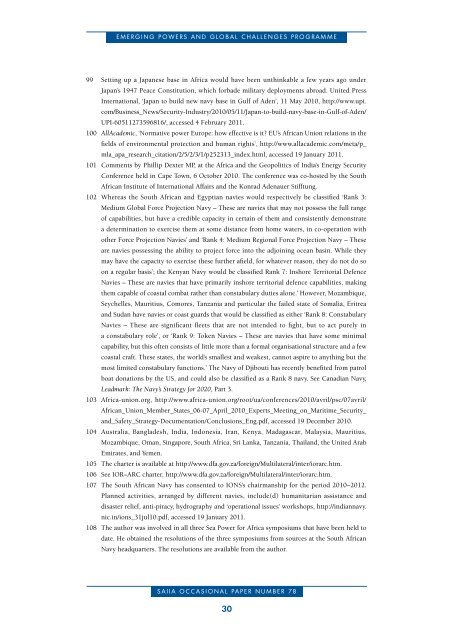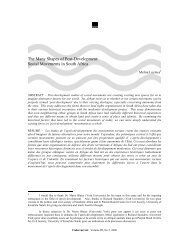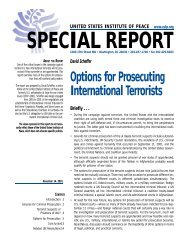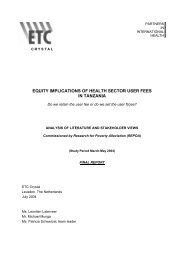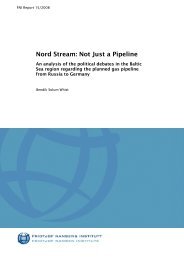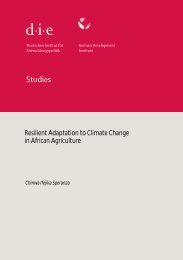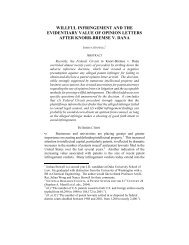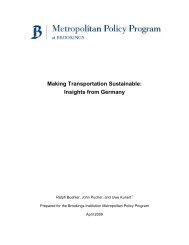Africa and the Geopolitics of the Indian Ocean
Africa and the Geopolitics of the Indian Ocean
Africa and the Geopolitics of the Indian Ocean
You also want an ePaper? Increase the reach of your titles
YUMPU automatically turns print PDFs into web optimized ePapers that Google loves.
EMERgINg POwERS ANd gLOBAL ChALLENgES PROgRAMME<br />
99 Setting up a Japanese base in <strong>Africa</strong> would have been unthinkable a few years ago under<br />
Japan’s 1947 Peace Constitution, which forbade military deployments abroad. United Press<br />
International, ‘Japan to build new navy base in Gulf <strong>of</strong> Aden’, 11 May 2010, http://www.upi.<br />
com/Business_News/Security-Industry/2010/05/11/Japan-to-build-navy-base-in-Gulf-<strong>of</strong>-Aden/<br />
UPI-60511273596816/, accessed 4 February 2011.<br />
100 AllAcademic, ‘Normative power Europe: how effective is it? EU’s <strong>Africa</strong>n Union relations in <strong>the</strong><br />
fields <strong>of</strong> environmental protection <strong>and</strong> human rights’, http://www.allacademic.com/meta/p_<br />
mla_apa_research_citation/2/5/2/3/1/p252313_index.html, accessed 19 January 2011.<br />
101 Comments by Phillip Dexter MP, at <strong>the</strong> <strong>Africa</strong> <strong>and</strong> <strong>the</strong> <strong>Geopolitics</strong> <strong>of</strong> India’s Energy Security<br />
Conference held in Cape Town, 6 October 2010. The conference was co-hosted by <strong>the</strong> South<br />
<strong>Africa</strong>n Institute <strong>of</strong> International Affairs <strong>and</strong> <strong>the</strong> Konrad Adenauer Stifftung.<br />
102 Whereas <strong>the</strong> South <strong>Africa</strong>n <strong>and</strong> Egyptian navies would respectively be classified ‘Rank 3:<br />
Medium Global Force Projection Navy – These are navies that may not possess <strong>the</strong> full range<br />
<strong>of</strong> capabilities, but have a credible capacity in certain <strong>of</strong> <strong>the</strong>m <strong>and</strong> consistently demonstrate<br />
a determination to exercise <strong>the</strong>m at some distance from home waters, in co-operation with<br />
o<strong>the</strong>r Force Projection Navies’ <strong>and</strong> ‘Rank 4: Medium Regional Force Projection Navy – These<br />
are navies possessing <strong>the</strong> ability to project force into <strong>the</strong> adjoining ocean basin. While <strong>the</strong>y<br />
may have <strong>the</strong> capacity to exercise <strong>the</strong>se fur<strong>the</strong>r afield, for whatever reason, <strong>the</strong>y do not do so<br />
on a regular basis’; <strong>the</strong> Kenyan Navy would be classified Rank 7: Inshore Territorial Defence<br />
Navies – These are navies that have primarily inshore territorial defence capabilities, making<br />
<strong>the</strong>m capable <strong>of</strong> coastal combat ra<strong>the</strong>r than constabulary duties alone.’ However, Mozambique,<br />
Seychelles, Mauritius, Comores, Tanzania <strong>and</strong> particular <strong>the</strong> failed state <strong>of</strong> Somalia, Eritrea<br />
<strong>and</strong> Sudan have navies or coast guards that would be classified as ei<strong>the</strong>r ‘Rank 8: Constabulary<br />
Navies – These are significant fleets that are not intended to fight, but to act purely in<br />
a constabulary role’, or ‘Rank 9: Token Navies – These are navies that have some minimal<br />
capability, but this <strong>of</strong>ten consists <strong>of</strong> little more than a formal organisational structure <strong>and</strong> a few<br />
coastal craft. These states, <strong>the</strong> world’s smallest <strong>and</strong> weakest, cannot aspire to anything but <strong>the</strong><br />
most limited constabulary functions.’ The Navy <strong>of</strong> Djibouti has recently benefited from patrol<br />
boat donations by <strong>the</strong> US, <strong>and</strong> could also be classified as a Rank 8 navy. See Canadian Navy,<br />
Leadmark: The Navy’s Strategy for 2020, Part 3.<br />
103 <strong>Africa</strong>-union.org, http://www.africa-union.org/root/ua/conferences/2010/avril/psc/07avril/<br />
<strong>Africa</strong>n_Union_Member_States_06-07_April_2010_Experts_Meeting_on_Maritime_Security_<br />
<strong>and</strong>_Safety_Strategy-Documentation/Conclusions_Eng.pdf, accessed 19 December 2010.<br />
104 Australia, Bangladesh, India, Indonesia, Iran, Kenya, Madagascar, Malaysia, Mauritius,<br />
Mozambique, Oman, Singapore, South <strong>Africa</strong>, Sri Lanka, Tanzania, Thail<strong>and</strong>, <strong>the</strong> United Arab<br />
Emirates, <strong>and</strong> Yemen.<br />
105 The charter is available at http://www.dfa.gov.za/foreign/Multilateral/inter/iorarc.htm.<br />
106 See IOR–ARC charter, http://www.dfa.gov.za/foreign/Multilateral/inter/iorarc.htm.<br />
107 The South <strong>Africa</strong>n Navy has consented to IONS’s chairmanship for <strong>the</strong> period 2010–2012.<br />
Planned activities, arranged by different navies, include(d) humanitarian assistance <strong>and</strong><br />
disaster relief, anti-piracy, hydrography <strong>and</strong> ‘operational issues’ workshops, http://indiannavy.<br />
nic.in/ions_31jul10.pdf, accessed 19 January 2011.<br />
108 The author was involved in all three Sea Power for <strong>Africa</strong> symposiums that have been held to<br />
date. He obtained <strong>the</strong> resolutions <strong>of</strong> <strong>the</strong> three symposiums from sources at <strong>the</strong> South <strong>Africa</strong>n<br />
Navy headquarters. The resolutions are available from <strong>the</strong> author.<br />
SAIIA OCCASIONAL PAPER NUMBER 78<br />
30


